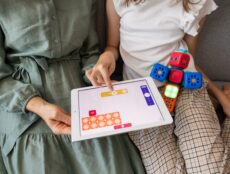
Articles
Op-Ed
Hybrid classrooms: Tips for teaching digital-native students online and in-person
By Fred Fransen
October 08, 2021
Many teachers and students found the sudden pivot to remote classrooms challenging. Imagine the added complexity of returning to in-person instruction, but still having a significant number of students opt to learn online.
Hybrid learning requires a new way of teaching and modern strategies for keeping students engaged. One strategy that works equally well for in-person and remote instruction focuses on how today’s digital native students like to learn.
To begin, teachers need an online curriculum that captures the attention of students. Not every student will be able to attend all online lectures and discussions, so it is important to have a curriculum that allows students to be self-directed.
What do online curriculums need?
The use of multimedia and visuals – Students today are used to viewing a steady stream of videos, pictures, and other visuals. They are comfortable in this environment. The best instructional curriculum includes this type of media to illustrate lessons.
Incorporating humor and pop culture – Social studies—economics, civics, and history—can be a little dry for teenagers. The use of humor and pop culture can go a long way in making these subjects relatable and interesting. In a survey conducted by Project Tomorrow®, 84% of students said that pop culture references and videos help them learn. In addition, 96% of teachers said pop culture references in the content are a valuable tool. A curriculum like Certell’s Poptential illustrates complex topics using humor and popular culture, so concepts don’t seem disconnected from students’ young lives.
Short readings – To compete with other things happening at home and to maximize short attention spans, readings should be digestible. Combined with multimedia, humor, and pop culture, short readings convey what’s important in a way that students can understand and relate.
Discussion worthy – A strong online curriculum fosters discussion. Since online classes are often limited to 45 minutes, 35 percent shorter than pre-COVID, time together should be spent introducing concepts and discussing the material so students can learn how to reason and think.
Free – Teachers rarely have a budget to purchase a curriculum, so cost is a consideration. There are good online courses, such as Certell, that are offered free to teachers.
Leveraging learning platforms
Platforms, like Google Classroom, can be utilized to share classwork and communicate with students. This is especially helpful during remote learning when students can’t attend a live Zoom session due to demands at home, like watching siblings.
Keep in mind that while at home, students have access to search engines, like Google. When posting discussion questions, frame them so the answers can’t be Googled. In other words, instead of asking for answers that are facts, ask questions that require students to think.
The key to classroom working—either in person or online—is a good curriculum that delivers the foundation for the lessons and conveys the information in a way that engages students.
Fred Fransen, Ph.D. is the CEO of Certell, a nonprofit that creates a sensible and entertaining social studies curriculum that animates the classroom and enables teachers to engage with and motivate today’s connected students.
Featured Image: Annie Spratt, Unsplash.









[…] April 15, the online learning platform Coursera debuted a new machine learning tool called CourseMatch. It automatically pairs university […]
[…] April 15, the online learning platform Coursera debuted a new machine learning tool called CourseMatch. It automatically pairs university […]
[…] Coursera Launches “AI for Everyone” (2018) […]